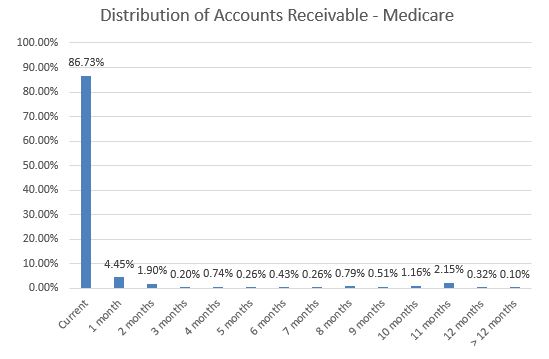
Aging Accounts Receivable
What is Aging Accounts Receivable?
The age of accounts receivable (AR) is the time that has elapsed from the time the agency delivered the service to the patient until current date. Aging AR is typically grouped into monthly buckets (e.g., 0-30 days, 31-60 days, etc.). Total dollar value of outstanding (aging) AR should be monitored each month, grouped by monthly buckets.

Consider the aging AR in the graph above. The horizontal axis shows different buckets of AR, where Medicare is the payer. “Current” represents dollars outstanding for services rendered within the most recent 30 days. “1 month” is dollars outstanding for services rendered in the most recent 31-60 days, etc. The vertical axis represents the percentage of the total Medicare dollar amounts of AR in each of the aging buckets.
How is the Accounts Receivable Distributed over Aging Buckets?
The high dollar amounts in the the first AR bucket followed by a drastic drop in outstanding AR is typical for the Medicare payer. Most agencies bill on a regular cycle (biweekly or monthly) so the large volume of outstanding AR in the “Current” bucket is mostly comprised of services that have not yet been billed out or have just been billed out to Medicare.
The outstanding AR drops but remains elevated in the “1 month” bucket. The agency is waiting to collect on services for which it has billed. It takes approximately 14 days to receive payment from Medicare. Aging AR is low in all remaining aging buckets. This is because the agency has billed and collected for most of its Medicare AR services.
What is Medicare Timely Filing?
Medicare claims must be filed no later than 12 months from the date services were provided. This includes resubmitting corrected claims that were unable to be processed. Again considering the aging AR in the graph above, note the volume of AR in the 10 month and 11 month aging buckets. AR in these aging buckets may be approaching Medicare’s timely filing deadline. Any claims in these buckets that have not yet been billed to Medicare will be not be able to be billed due to timely filing. The agency should quickly investigate the AR in these buckets.
Most agencies have a greater than 99% collection rate for Medicare AR. There should not be significant Medicare AR that is uncollectible.
In addition to monitoring total dollar value of aging AR, there are other useful classifications and breakdowns of aging AR that should be monitored on a monthly or even weekly basis.
